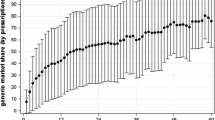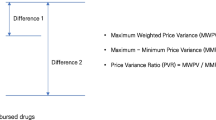Abstract
Generic substitution policy has been adopted in several countries in order to control health expenditures. Using a model based on incentives, this work aims to analyze the response of doctors and pharmaceutical companies to the implementation of this policy. It is shown that after the implementation of GSP, the effort of doctor’s convincing the patient to take generics increase or decrease depending on his level of concern for patient well-being; pharmaceutical companies decrease the amount of detailing and the market share of generics tends to increase.

Similar content being viewed by others
Explore related subjects
Discover the latest articles, news and stories from top researchers in related subjects.Notes
Birkett (2003) defined bioequivalence by stating that, “two pharmaceutical products are bioequivalent if they are pharmaceutically equivalent and their bioavailabilities (rate and extent of availability) after administration in the same molar dose are similar to such a degree that their effects, with respect to both efficacy and safety, can be expected to be essentially the same. Pharmaceutical equivalence implies the same amount of the same active substance(s), in the same dosage form, for the same route of administration and meeting the same or comparable standards.”
There are incentives for pharmacist but we do not focus on these in our analysis.
Big Pharma’s favorite prescription: higher prices, in http://www.bloomberg.com/bw/articles/2014-05-08/why-prescription-drug-prices-keep-rising-higher.
Second order conditions are satisfied: \(\frac{\partial }{\partial e} EU^{S}(e,D)=-1\,<\,0\).
This is the case if and only if \(\Delta >\pi \) by Proposition 5.
References
Aalto-Setala V (2008) The impact of generic substitution on price competition in Finland. Eur J Health Econ 9:185–191
Andersson K et al (2005) What are the obstacles to generic substitution? An assessment of the behavior of prescribers, patients and pharmacies during the first year of generic substitution in Sweden. Pharmacoepidemiol Drug Saf 14:341–348
Birkett DJ (2003) Generics---equal or not? Aust Prescr, 26:85–87. http://www.australianprescriber.com/upload/pdf/articles/712. Accessed 2 April 2015
Brekke KR et al (2013) Margins and market shares: pharmacy incentives for generic substitution. Eur Econ Rev 61:116–131
Brick A et al (2013) Usage of generics in Ireland: recent trends and policy developments. J Generic Med 10(2):72–85
Burtka AT (2007) Drug companies go too far to influence doctors, critics say, news & trends. Am Assoc Justice 43(10)
Chandon P (2004) Innovative marketing strategies after patent expiry, the case GSK’s antibiotic Clamoxyl in France. Int J Med Mark 24(1):65–73
Decollogny A et al (2011) Determinants of generic drug substitution in Switzerland. BMC Health Serv Res 11:17
Fuhrmans V (2008) Doctors paid to prescribe generic pills. Wall Street J Online
Gaither CA et al (2001) Consumers’ view on generic medications. J Am Pharm Assoc 41(5):729–736
Garattini L, Tediosi F (2000) A comparative analysis of generics market in five European countries. Health Policy 51:149–162
Harder B (2005) Pushing drugs: how medical marketing influences doctors and patients. Sci News 168(5):75–76
Harris G (2004) Medical marketing—treatment by incentives, as doctor writes prescription, drug company writes a check. New York Times, 27
Hassali MA et al (2014) The experiences of implementing generic medicine policy in eight countries: a review and recommendations for a successful promotion of generic medicine use. Saudi Pharm J 22:491–503
Hellerstein J (1998) The importance of the physician in the generic versus trade-name prescription decision. Rand J Econ 29(1):108–136
Hudson J (2000) Generic take-up in the pharmaceutical market following patent expiry, a multi-country study. Int Rev Law Econ 20:205–221
Koskinen H et al (2015) Time series analysis on the impact of generic substitution and reference pricing on antipsychotic costs in Finland. Value Health 18:1105–1112
Lexchin J (2004) The effect of generic competition on the price of brand-name drugs. Health Policy 68:47–54
Mason J, Bearden W (1980) Generic drugs: consumer, pharmacist and physician perceptions on the issues. J Consum Aff 14(1):193–206
Merino-Castello A (2003) Demand for pharmaceutical drugs, a choice modelling experiment, WP 704/2003. University Pompeu Fabra, Barcelona
Morton FMS (2000) Barriers to entry, brand advertising, and generic entry in the US pharmaceutical industry. Int J Ind Org 18:1085–1104
Mossialos E, Oliver A (2005) An overview of pharmaceutical policy in four countries: France, Germany, Netherlands and UK. Int J Health Plan Manag 20:291–306
Perry G (2006) The European generic pharmaceutical market in review: 2006 and beyond. J Generic Med 4(1):4–14
Regan TL (2008) Generic entry, price competition, and market segmentation in the prescription drug market. Int J Ind Org 26:930–948
Rischatsch M (2013) Generic substitution, financial interests, and imperfect agency. Int J Health Care Financ Econ 13:115–138
Tilson L et al (2005) The potential impact of implementing a system of generic substitution on the community drug schemes in Ireland. Eur J Health Econ 50:267–273
Wazana A (2000) Physicians and the pharmaceutical industry, is a gift ever just a gift? JAMA 283(3):373–380
Author information
Authors and Affiliations
Corresponding author
Appendices
Appendix: Proofs
1.1 Observation
We must show that there exist two functions f and g such that one can express the joint distribution of prescription and sales signals as \( P(i,j)=f(i,e)g(i,j)\), for all \(i=B,G\) and \(j=B,G\). Indeed, let
and let
Then
as given in the text.
The substitution policy is implemented
Lemma 1
The pharma’s objective function \(EP^{S}(D,e)=(1-e)\left[ \left( 1-\varphi \right) \pi -D)\right] \).
If \(e=0,W-D+\left( 1-\varphi \right) \Delta \le 0\) , then \( EP^{S}(D,0)=\left( 1-\varphi \right) \pi -D.\)
If \(e=1\), \(W-D+\left( 1-\varphi \right) \Delta \ge 1\) , then \(EP^{S}(D,1)=0\) .
After substituting the doctor’s effort \(e^{S*}=W-D+\left( 1-\varphi \right) \Delta ,\)
we can write
From FOC we get \(D^{S*}=\frac{1}{2}\left[ \left( 1-\varphi \right) \left( \pi +\Delta \right) +W-1\right] \) and \(D^{S*}>0.\)
For this solution to be interior we need
-
(i)
\(W+\left( 1-\varphi \right) \Delta -1<D^{S*}<W+\left( 1-\varphi \right) \Delta \)
-
(ii)
\(D^{S*}=\frac{1}{2}\left[ \left( 1-\varphi \right) \left( \pi +\Delta \right) +W-1\right] >0.\)
Analyzing these inequalities
Therefore, we can deduce the following:
\(D^{S*}\) is interior (which implies that \(e^{S*}\) is also interior) if and only if
Moreover, from the no-GSP conditions to ensure interior solutions, we know that
Thus, the conditions that guarantee interior solutions in no-GSP and GSP can be stated as it follows:
\(\left( 1-\varphi \right) \left( \pi -\Delta \right) +1\}.\)
Let’s take
So we have \(max\{0;A;B;C;D\}<W<min\{E;F\}\)
We next analyze these conditions.
-
(A)
\(min\{E;F\}=F=\left( 1-\varphi \right) \left( \pi -\Delta \right) +1\)
-
(B)
\(max\{0;A;B;C;D\}=max\{0;A;B;C\}\) because \(C>D\).
Case 1 : Suppose \(\Delta \ge \pi ,\) then \( max\{0;A;B;C\}=max\{0;C\}\) because \(A<0\) and \(B<0\).
\(C>0\) if \(1-\left( 1-\varphi \right) \left( \pi +\Delta \right) >0\Leftrightarrow (1-\varphi )\pi +(1-\varphi )\Delta<1\Leftrightarrow \pi < \dfrac{1}{1-\varphi }-\Delta .\)
When \(C>0\) then \(max\{0;C\}=C.\)
Case 2: Suppose \(\Delta <\pi ,\) then \(max\{0;A;B;C\}=max\{0;B;C\}\) because \(B>A\).
Note that \(B=(\pi -\Delta )-1>0\Leftrightarrow \pi >\Delta +1.\)
Case 2.1 When \(B<0\) and \(C<0\).
Then, \(max\{0;B;C\}=0.\)
Case 2.2 When \(B<0\) and \(C>0\).
Then, \(max\{0;B;C\}=C.\)
Case 2.3 When \(B>0\) and \(C>0\).
Then, \(max\{0;B;C\}=C\) if \(\pi <\dfrac{2+\varphi \Delta }{2-\varphi }\)
or \(max\{0;B;C\}=B\) if \(\pi >\dfrac{2+\varphi \Delta }{2-\varphi }.\)
Summing up, we get Lemma 1
-
(1)
Suppose \(\Delta \ge \pi .\)
-
(1.1)
If \(\pi <\dfrac{1}{1-\varphi }-\Delta ,\) then \(C<W<F.\)
-
(1.2)
If \(\pi >\dfrac{1}{1-\varphi }-\Delta ,\) then \(0<W<F.\)
-
(2)
Suppose \(\Delta <\pi .\)
-
(2.1)
If \(\pi <\dfrac{1}{1-\varphi }-\Delta \) then \(0<W<F.\)
-
(2.2)
If \(\dfrac{1}{1-\varphi }-\Delta<\pi <\Delta +1\) then \(C<W<F.\)
-
(2.3)
If \(\pi >\Delta +1\) and \(\pi >\dfrac{2+\varphi \Delta }{ 2-\varphi }\), then \(B<W<F.\)
-
(2.4)
If \(\pi >\Delta +1\) and \(\pi <\dfrac{2+\varphi \Delta }{ 2-\varphi }\), then \(C<W<F\)
Lemma 2
We have \(\Pr ^{N}\left( G\right) =e^{*N}\) and
Moreover, \(\ e^{N}(D)=W+\Delta -D,\) \(e^{S*}=W-D+(1-\varphi )\Delta \) and D is fixed \(\overline{D}=D^{N*}=\frac{1}{2}(\pi +W+\Delta -1)\)
Proposition 5
Note that \(e^{N*}=\frac{1}{2}+\frac{1}{2}(W+\Delta -\pi )\) and \(e^{S*}=\frac{1}{2}\left[ W+1+\left( 1-\varphi \right) \left( \Delta -\pi \right) \right] .\)
Note that \(e^{N*}=\frac{1}{2}+\frac{1}{2}(W+\Delta -\pi )\) can be written as \(\frac{1}{2}+\frac{1}{2}W=e^{N*}+\frac{1}{2}\left( \pi -\Delta \right) \).
Then we can also write
The last expression is larger than or equal to \(e^{N*}\) if and only if \( \frac{1}{4}\left( \pi -\Delta \right) \left( 1+\varphi \right) \ge 0\), or \( \pi \ge \Delta \).
Lemma 3
Assume \(\Delta >\pi \) and interior solutions of e.
Under no-GSP:
The condition is positive so first term is positive and second term is negative because \((W+\pi +\Delta )>(W+\Delta -\pi )\).
Under GSP:
As above, the condition is positive so most likely first term is positive and second term is negative because
Then, cross comparing terms under no-GSP and under GSP:
and
The (increasing) variation in the first component is equal to \(\frac{1}{2} \left( \Delta -\pi \right) \varphi \)
The (decreasing) variation in the second component is equal to \(\frac{1}{2} \left( \Delta +\pi \right) \varphi \)
The stronger effect is the decreasing effect.
Hence, \((1-e^{N*})D^{N*}>(1-e^{S*})D^{S*}.\)
Proposition 6
When \(\Pr ^{N}\left( G\right) >\Pr ^{S}\left( G\right) \)
We know \(e^{S*}=\frac{1}{2}\left[ W+1+\left( 1-\varphi \right) \left( \Delta -\pi \right) \right] \) and \(e^{N*}=\frac{1}{2}(1+W+\Delta -\pi ),\) so
Let \(W_{\min }=(2-\varphi )(\pi -\Delta )+1.\)
Taking into account the conditions stated in Lemma 2, it is easily proven that \(W_{min}\) cannot lead to interior solutions.
Recall that \(min\{E;F\}=F=\left( 1-\varphi \right) \left( \pi -\Delta \right) +1.\)
It is always verified that \(W_{\min }>F\). Thus, \(W_{min}\) doesn’t satisfy the conditions of Lemma 2 and so \(\Pr ^{N}\left( G\right) >\Pr ^{S}\left( G\right) \) cannot happen for the optimal interior solutions of e and D.
Rights and permissions
About this article
Cite this article
Tavares, A.I. Generic substitution policy, an incentive approach. Comput Math Organ Theory 23, 199–220 (2017). https://doi.org/10.1007/s10588-016-9223-3
Published:
Issue Date:
DOI: https://doi.org/10.1007/s10588-016-9223-3




